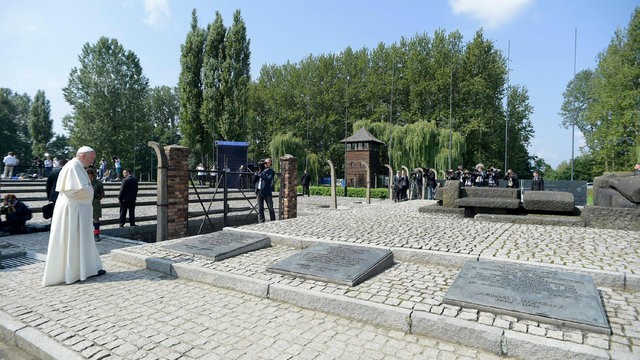Pope in silent tribute at Auschwitz

Pope Francis has paid a sombre visit to Auschwitz, praying in silence and meeting Holocaust survivors at the Nazi death camp in Poland where 1.1 million people were killed.
The Pope walked beneath the gates marked with the words arbeit macht frei – work sets you free – before sitting alone on a bench at the extermination site in quiet contemplation.
Pope Francis had said he wanted only silence and tears during the visit: "I would like to go to that place of horror without speeches, without crowds – only the few people necessary. Alone, enter, pray. And may the Lord give me the grace to cry."
At Block 11, the Pope met a group of former prisoners and some of those hailed as "righteous among nations" for risking their lives to save Jews.
One passed him a lit candle, which the Pope carried to the "wall of death" at the end of the block's yard, where several thousand were shot dead.
At the cell of Maximilian Kolbe, a Franciscan priest who volunteered to take the place of a prisoner selected for death, Pope Francis spent several minutes alone.
Kolbe was killed on 14 August 1941 and was later canonised by Pope John Paul II.
This papal visit falls on the 75th anniversary of the day Kolbe was condemned to death.
After signing a visitors' book, Francis went to the adjacent camp at Birkenau, while Psalm 130 – "Out of the depths I cry to you, Lord" – was recited by a rabbi in Hebrew.
The vast majority of those who were killed Aushwitz-Birkenau were Jewish, but thousands of Polish Catholics, Roma and Soviet prisoners of war also lost their lives.
The Polish president, Andrzej Duda, and prime minister, Beata Szydło accompanied the Pope along with Father Stanislaw Ruszala, the parish priest of Markowa, where in 1942 the parishioners Josef and Wiktoria Ulma and their seven children were shot dead for sheltering eight Jews.
The visit by Pope Francis to Auschwitz follows that of John Paul II in 1979, and of Pope Benedict XVI in 2006.











